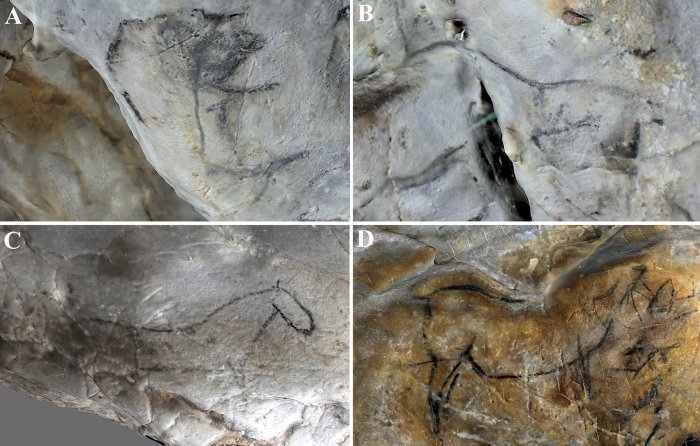Jan Bartek – AncientPages.com – Scientists propose a psychological phenomenon where people see meaningful forms in random patterns, such as seeing faces in clouds, may have stimulated early humans to make cave art.

Ortho-images (orthorectified image accounting for distortions in the topography of the cave wall) of depictions that are simple in style and have a strong relationship to topographic features of the cave wall from Las Monedas. (A) depiction 5; (B) depiction 8; (C) depiction 12; (D) depiction 30. Credit: Cambridge Archaeological Journal
Research published in the Cambridge Archaeological Journal by the departments of Archaeology and Psychology at Durham University has found that Ice Age cave art made as early as 40,000 years ago was influenced in part by a visual psychological phenomenon called pareidolia.
Pareidolia and early human artists
The research team, led by Dr. Izzy Wisher, who was a Durham Ph.D. student at the time of the study, examined paintings of animals in caves in Northern Spain to look for any evidence that pareidolia had an influence on the early artists.
If so, they would have expected the majority of depictions to include features of the cave walls within them (such as cracks and curves) and to take relatively simple forms.
The researchers also used modified virtual reality gaming software to model the cave walls and replicate the light sources used by the artists, (most likely flickering firelight produced by small torches or lamps), to understand the visual effects on the cave wall by tracking the eye-movement of participants.
Influence and inspiration
Their study found that over 50% of depictions showed a strong relationship to the natural features of the cave wall and were simple in nature (lacking detail such as eyes or hair), suggesting strongly that pareidolia partly guided artists’ creations.

A Paleolithic painting of an aurochs from the cave of La Pasiega. The Paleolithic artist traced the natural cracks in the cave wall when painting the head, horns, and back leg of the animal. Credit: Izzy Wisher, courtesy of the Gobierno de Cantabria
Examples included where the curved edges of the cave wall were used to represent the backs of animals such as wild horses, or where natural cracks were used as bisons’ horns.
However, pareidolia cannot explain all the images and the researchers believe that the art may have been part of a “creative conversation” with the cave walls—with early artists both guided by what they saw emerging from the cracks and shapes of the cave wall, but also using their own creativity.
Systematic testing
The team believes their study offers the first systematic testing of the much-discussed theory that pareidolia influenced cave artists and is the first to utilize simulated lighting conditions in virtual reality as part of this.
It advances Durham’s research into visual paleopsychology.
The study was published in the Cambridge Archaeological Journal
Written by Jan Bartek – AncientPages.com Staff Writer





